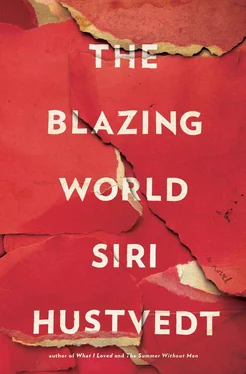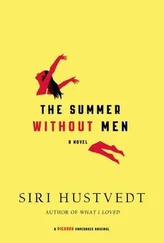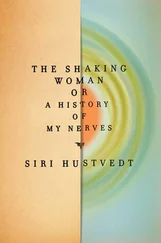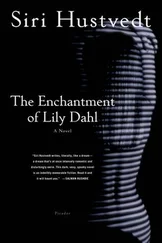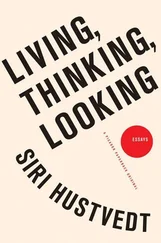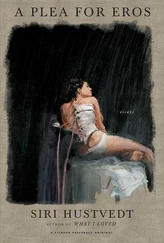This may pass for a philosophical statement, I suppose. We were both confirmed atheists, but what fascinated me about the man was that with me, too, he changed from one day to the next. He talked a lot about “honing his image” and his “self-presentation,” his need to “nail down a game plan.” But then he would confess to a desire to make art that would “slice people open” and “shake them hard.” According to Katy, he wept regularly over newspaper articles about dead and/or abused children, gave money to a host of animal charities, and professed vegetarianism. It may have been a phase. With me, he ate meat.
Rune was a fabulist. He reinvented himself again and again ceaselessly until the end. In this respect, he was a man of our time, a creature of the media and of virtual realities, an avatar walking the earth, a digitized being. No one knew him. His comment about his autobiography as a “fake” is at once deep and shallow. And that is the point. There can be no depth in our world, no personality, no true story, only images without substance projected anywhere and everywhere instantaneously. Soon we will have communication devices implanted directly into our brains. The distinctions between reality and image are already fading. People live in their screens. Social media is replacing social life.
I saw Harriet Burden with Rune once at his place not long after Beneath had been mounted. I liked to refer to Rune’s warehouse conversion as “Versailles on the Hudson.” The elevator held twenty. The rooms were stupendously large, with monumental sofas and overstuffed chairs covered in brocades, silks, and velvets in brilliant colors, streaming with light. “I wanted it to look like a Hitchcock movie, a Technicolor extravaganza,” he said. His own gigantic film stills were hanging everywhere. His girlfriend at the time, Fanny-something (former Victoria’s Secret model), drifted in and out wearing Ugg boots and cut-off jeans. “I need a pan for the brownies, Rune.”
Sometime later, Felix Lord’s widow was ushered into the room by some underling who had answered the door, and there, in harsh contrast to the lithe and lovely Fanny, stood the enormous Harriet, a shrill presence even before she had opened her mouth. I knew she had been buying and selling art, had spied her at a few openings, but I had not spoken to her since the day I met her at Tish’s studio. She greeted me coldly, sat down, and said nothing for a while. Rune and I talked about AI, an interest we shared, when she interrupted us with a harsh comment to the effect that AI scientists couldn’t even make a robot that walked like a human being, for God’s sake. Then she started in on consciousness, as if she were some kind of expert, and then I mentioned Beneath . She called it a big change after the crosses. I was polite. I humored her. I said it was the oscillation in Rune’s work that was interesting — the movement from one position to the other — but that his work was always about bodies, technology, and simulation, this time in disaster mode.
She interrupted us. “I don’t see how Beneath is about technology.”
I mentioned the robot dance.
“Why do you think those figures are robots?”
Rune took my side. The dancers had robotic movements, he said, sure, in line with his earlier work. Most of the reviews, he said, had described them that way.
I merely echoed this comment, saying that it was obvious to everyone.
This set her off. Her voice rose an octave. She asked who “everyone” was, said I was blinded by context and so were the other fools, or something to that effect. She accused me of multiple failings as a writer, most of which I can’t remember. I was embarrassed for her, really, and wasn’t going to egg her on with a response. This annoyed her further. Women who resort to wailing have always had a chilling effect on me. My admittedly brief marriage ended because I became allergic to my wife’s voice. Since then, I only consort with women who keep their tones low and dulcet. The Harriet tirade lasted seven, maybe ten minutes. Rune tried to placate her: “Harry, Harry, it’s not important. Relax. Come on.” The upset ended with her sweeping up her coat and hat and making a grand exit.
I had no sense that the two were collaborators. It was obvious that Rune was calling the shots. I asked him what her problem was, and he said she was overly sensitive, a bit unstable, but a friend. I would like to note here that he defended her: “People don’t understand Harry, but she’s highly intelligent. She’s stuck on her own view, that’s all. I admire her for it.”
After Harriet left, Rune and I strayed onto the meanings of money, that eternal American subject. He had never seen real money before he came to New York. His hometown, Clinton, Iowa, had rolled in the glories of lumber riches in the second half of the nineteenth century, but when the forests were depleted around 1900, the wealth died with the trees. He had grown up with the moldering mansions and ragged parks left by long-dead millionaires, but in New York City those riches had been reborn in the body of Rena Dewitt. “Her soul was made of money,” he said. My own initiation had come at Yale, where I witnessed firsthand the casual assumptions of class, its ease and smugness, the lawns and paintings and town houses that lurked behind the friendly but distant smile. Of course we need the rich. We always have: to ogle and envy and imitate. They are our spectacle and our joy because in the head of every American lies the thought That could be me . ( That could be I , grammatically correct though it is, does not lurk within our collective heart, not anymore.) The rich constitute our mythos, after all, our fairy tale, our hymn to success: the self-made man, the robber baron, dog-eat-dog, rugged individualism, nice guys finish last, carry your own gun and ride in your own limousine, long-legged babes with enhanced boobs on either side of you as you drive to the premiere and exit the car, flashbulbs exploding around you. There is still old money around, quiet and hidden and stealthy, but it has no grip on the public imagination as it once did. The social register, the 400, the debuts — still around, but there are fewer and fewer Philadelphia stories told in our world of Twitter and Facebook.
Rune and Rena — a gleaming pair. “Rune, the Rube,” he joked, “learned fast.” He learned because in the United States there is still a teeny-weeny bit of truth in the myth. Millionaire hairdressers hobnob with heiresses. Cowboy traders, suddenly flush, saunter through the doors of the Metropolitan Museum for a gala. The actress, once the kept paramour of Mr. Old Money slumming backstage, is now royalty in her own right. The newly minted artist buys up lofts and houses right and left. I have seen it all. Believe me. They’re up. They’re down. They soar and they crash. I am nobody’s conscience, but I am the man who looks on at the fiascos and the greed and the pills and the booze and the bouts in rehab. And I still have a job. I am still in my comfortable apartment, and I am invited to dinner a couple of times a week with people who count. I own two tuxedos. No one remembers the Crawler, but the techniques I used then are still good, and I have what cannot be faked: wit. It is a commodity in short supply.
The art of conversation has been dwindling steadily until there is nearly no art left, but I do my best to resurrect it when I can. And I understand the power of the compliment, which must always seize upon a truth. I told Rune that day that he was fascinatingly elusive, that he held my interest not only because I admired his work but because he embodied contradictions I felt in myself. I am continually torn between admiration and contempt for the circus of vanity and stupidity I witness every day and on which I dutifully report. I admire the ruthless vigor of the climbers, but I often bemoan their lack of style. I feel the pull to the future, the revolution of the digital age, but I long for the literate niceties of the past, for a touch of romance and courtesy.
Читать дальше
